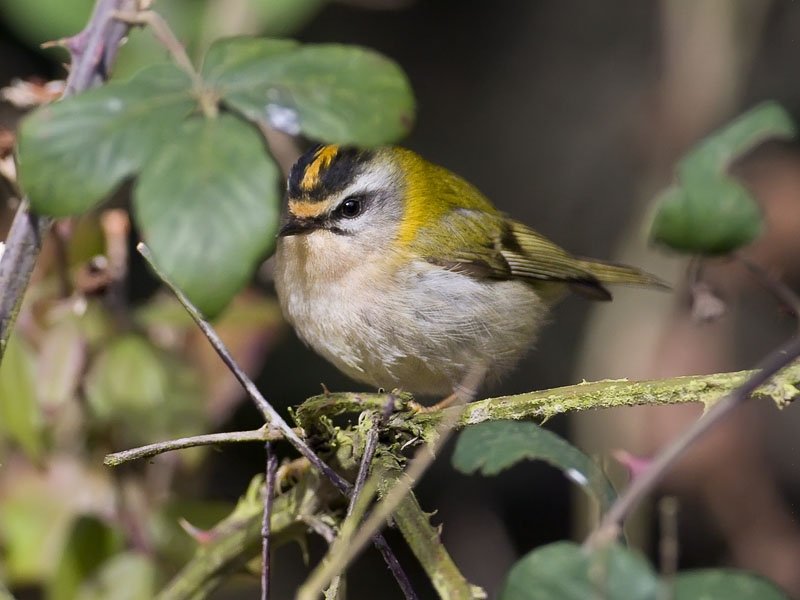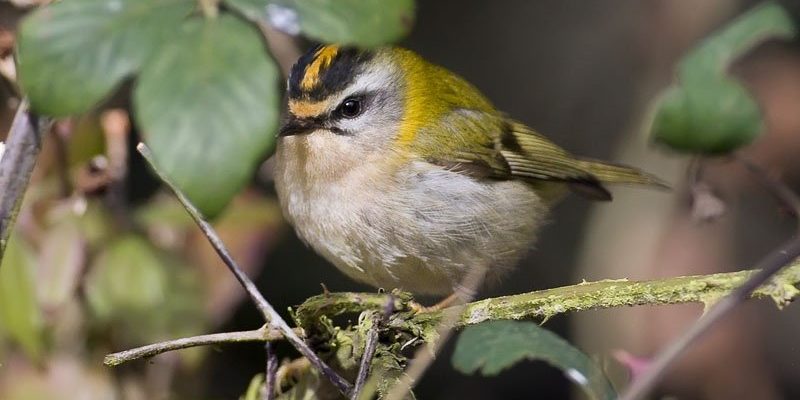
Have you ever spotted a tiny bird flitting through the trees, looking like a little ball of fire? That’s likely the Firecrest, one of the smallest and most colorful birds you might encounter in Europe. Its bright plumage and lively demeanor make it a delight to observe. But there’s so much more to this bird than just its looks!
The Firecrest is not just pretty; it’s also fascinating in terms of behavior, habitat, and conservation status. Imagine a little creature that brings a splash of color to your woodland walks, flitting between branches and singing sweet melodies. This article dives into everything you need to know about the Firecrest, so grab your binoculars and let’s explore!
Identifying the Firecrest
Identifying the Firecrest is relatively simple once you know what to look for. These tiny birds measure about 9-10 cm in length, making them just a bit bigger than a common wren. They feature a striking olive-green body, with a distinctive crown of orange or yellow on top of their heads, which can be quite eye-catching. The males tend to boast brighter colors compared to females, with the male’s crown displaying a vibrant orange that can easily be missed if you’re not paying attention.
When observing a Firecrest, you’ll likely notice its pretty face, which is adorned with a bold white stripe running through the eye, alongside a soft, pale throat. Their wings are dark with a striking white wing bar, adding to their charm. These features can sometimes make them resemble their distant relatives, the Goldcrests, but look closely—the Firecrest is generally a bit more colorful and lively!
Another great way to identify a Firecrest is by its song. The Firecrest has a unique and cheerful series of high-pitched notes that sound almost like a tiny whistle. It’s fascinating to think that such a small bird can create such a joyful sound, making it easy to locate even if you can’t see it right away!
Habitat and Distribution
Firecrests thrive in forests, particularly those with plenty of conifers and mixed woodlands. They prefer areas where they can easily dart through the branches in search of food. You’ll often find them in woodland edges and gardens, as well as parks—places where the trees provide cover and food sources are abundant.
In terms of distribution, Firecrests are primarily found across Europe, with a strong presence in the UK and parts of Scandinavia. During winter, they can make their way to southern Europe, which is a smart move considering the harsher climates of their northern habitats. Think of it as their version of a holiday! They tend to be migratory, but not in the traditional sense. Their movements are more localized, as they shift around depending on food availability and weather conditions.
Interestingly, Firecrests are not just tied to dense forests. They can adapt to urban settings too! You might spot them in city parks or gardens, especially those with plenty of trees. This adaptability is reminiscent of how some people thrive in bustling environments. The Firecrest, with its vibrant personality, brings life to any space it occupies.
Diet and Feeding Habits
When it comes to diet, Firecrests are primarily insectivorous, feasting on small insects, spiders, and other invertebrates. Their favorite food sources include caterpillars, aphids, and various tiny bugs they can find while foraging among leaves and branches. Picture a small creature darting from leaf to leaf, poking its beak into hidden crevices to find a tasty snack!
In addition to insects, Firecrests also enjoy nectar from flowers, which provides them with the energy they need to thrive. Their ability to consume nectar makes them quite similar to hummingbirds, who are also known for their quick movements and colorful appearances. You might imagine them zipping around, almost like little fairy sprites, in search of their next meal.
During colder months, when insects become scarce, Firecrests can adapt their diet by consuming seeds and berries as well. They have a knack for finding food sources that are not easily accessible to larger birds. This adaptability showcases their resourcefulness, as they know how to survive in changing conditions. If you ever get a chance to observe these birds, you’ll likely see them actively foraging—always on the move!
Breeding and Nesting
The breeding season for the Firecrest typically runs from late March to early August. During this time, male Firecrests become particularly territorial and vocal, showcasing their bright colors to attract a mate. This stage of their life is filled with energy, as they sing passionately among the branches, vying for the attention of potential partners.
When it comes to nesting, Firecrests prefer to build their homes in dense foliage, usually near the ends of branches where they feel safe from predators. They construct their nests using a blend of moss, feathers, and spider silk, creating a cozy and camouflaged home for their young. Think of it like crafting the perfect little hideaway—a safe spot where they can raise their chicks away from prying eyes.
Once the female lays her eggs, typically between 4-8 eggs, she assumes the responsibility of incubating them while the male guards the territory. After about two weeks, the eggs hatch, and both parents work together to feed the hungry chicks. It’s a beautiful partnership that showcases the nurturing side of these tiny birds. Imagine those little ones, mouths gaping wide, waiting for their parents to return with food!
Conservation Status
Fortunately, the Firecrest is currently not considered endangered. Their flexible habitat preferences and adaptability have helped them maintain stable populations in many areas. However, like many other bird species, they do face challenges due to habitat loss and climate change. These factors can impact their food sources and breeding grounds, which is why conservation efforts are important.
Birdwatchers and conservationists play a crucial role in monitoring Firecrest populations and ensuring their habitats remain protected. By preserving woodlands and promoting biodiversity, we can help ensure these vibrant little birds continue to thrive for generations to come. Think of it as a team effort, where every action counts towards creating a healthier environment for all wildlife!
Moreover, Firecrests are indicators of a healthy ecosystem. Their presence often suggests that the woodland is thriving, serving as a reminder of the interconnectedness of nature. The more we can do to protect their habitats, the better off we all are. Every little bird has a big role to play in the balance of our world.
Interesting Facts About Firecrests
| Scientific Name: | Regulus ignicapillus |
| Size: | 9-10 cm (3.5-4 inches) |
| Wingspan: | 11-13 cm (4.3-5.1 inches) |
| Weight: | 6-7 g (0.21-0.25 oz) |
| Diet: | Insects, spiders, nectar |
| Lifespan: | 2-4 years in the wild |
| Breeding Season: | Late March to August |
| Eggs per Clutch: | 4-8 eggs |
FAQ
Where can I find Firecrests?
You can find Firecrests primarily in woodlands and forests across Western and Central Europe. They thrive in areas with coniferous and mixed trees, but you might also catch a glimpse of them in parks and gardens, especially during the breeding season. Just keep an eye out for their distinctive colors and listen for their cheerful songs!
Do Firecrests migrate?
Firecrests tend to exhibit localized movements rather than long-distance migrations. During winter months, they may move southward to find milder climates and more abundant food sources, but they generally stay within the same region. This behavior allows them to adapt to changing conditions while remaining close to their preferred habitats.
How long do Firecrests live?
In the wild, Firecrests typically live for about 2 to 4 years. However, some individuals may live longer if they manage to avoid predators and find plentiful food. Lifespan can be influenced by various factors, including habitat quality and environmental conditions, which play a vital role in their survival.
What do Firecrests sound like?
Firecrests have a delightful song that consists of high-pitched, whistling notes. Their vocalizations are often cheerful and melodious, making them stand out among other birds in the forest. If you hear a bright, tinkling sound while out walking, it could very well be a Firecrest singing nearby!
What threats do Firecrests face?
While Firecrests are currently not endangered, they do face threats from habitat loss, climate change, and pollution. Deforestation and urban development can reduce their natural environments, leading to decreased food availability and nesting sites. Conservation efforts are crucial to help protect their habitats and ensure their continued survival.
Can Firecrests be kept as pets?
Firecrests are wild birds and are not suitable as pets. They require specific habitats and diets to thrive. Additionally, keeping wild birds as pets can be harmful to their populations and disrupt the ecosystem. It’s best to admire these beautiful creatures in their natural environment where they can live freely.
What is the best time to observe Firecrests?
The best time to observe Firecrests is during the spring and early summer months when they are breeding and more active. During this time, their vibrant colors and lively behavior are on full display. Early mornings or late afternoons are often the most productive times for spotting these enchanting birds.
Do Firecrests form flocks?
Firecrests are usually solitary or found in pairs, especially during the breeding season. However, they may join mixed-species flocks during the non-breeding season to forage for food. These flocks can include other small birds, creating a lively and bustling atmosphere in the trees.
How do Firecrests adapt to their environment?
Firecrests have remarkable adaptability, allowing them to thrive in various habitats, from dense forests to urban gardens. Their diet can shift depending on food availability, as they feed on insects, nectar, and berries throughout the seasons. This flexibility ensures they can survive even when faced with changing conditions.
Are Firecrests social birds?
Firecrests are generally not social birds. They prefer to live in pairs or alone, particularly during the breeding season. However, during the winter months, you might see them joining mixed-species flocks. This behavior helps them find food more efficiently, as they can work together with other birds to locate resources.
How can I help Firecrests?
To help Firecrests, you can support local conservation efforts aimed at preserving their natural habitats. Planting native trees and shrubs in your garden can also provide food and shelter for these birds. Additionally, reducing pesticide use helps ensure a healthy supply of insects for them to eat. Every small action contributes to the well-being of these fascinating creatures!

